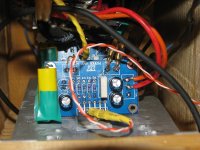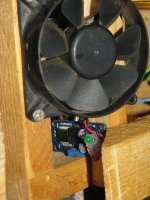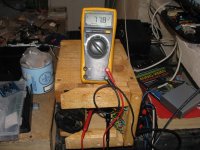Hi. I have a class AB amplifier design with a BJT output stage. The BJT's are TO-220 cases that's screwed to the bottom of the case for heat sinking, they are dissipating something like 3W each. Everything works just dandy, but I don't feel a 100% safe, what if the screws for the BJT's were to loosen? Taking thermal runaway into account I'm not sure what can happen to a non cooled TO-220 package in a closed environment like this, I guess it would just heat to the point where something breaks. I'm not very fond of this scenario so I would like some thermal protection. I guess one idea is to thermally glue a thermistor to each BJT and use some comparator circuit to break the power to the amp. Another idea would be to thermally glue four thermal circuit breakers to the BJT's and connect them in series, but I don't know how wise it is to run the supply across the amplifier board like that (thinking of noise coupling)? The best option would be to use some chip with internal thermal protection, like the LM1875, but I've failed to find a unity gain stable power amplifier chip that has a decent quiescent current draw (I want it to get hot)  Are there fancy BJT's with internal thermal protection out there?
Are there fancy BJT's with internal thermal protection out there?
Is it a manufactured or a DIY amplifier? There were some British closed box designs with chassis used as heat sink (B&W Aura springs to mind). The main concern in these designs was not thermal overload of outputs but rather the long-term effects of heat on components and joints in a hot, non-vented enclosure. And Auras were known to suffer from some issues due to internal heat.
I would start by measuring the temperature on either of the concerned bjt's and see if they reach any significant temperatures under load and in different ambient temperatures.
I would start by measuring the temperature on either of the concerned bjt's and see if they reach any significant temperatures under load and in different ambient temperatures.
It's a DIY amplifier and it gets pretty hot, but I don't really have a thermometer so I don't know the exact temperatures. I've been concerned with the heat over time, perhaps especially the electrolytic caps, but I've tried to countered it by using decent quality caps. I'm not sure if any other component or the PCB can take issue with the heat?
My DMM didn't come with a temperature sensor. I guess I could make holes, but what difference would that make? The heat is transferred from the bottom plate to the top plate and further cooled by the air, I can't see how making holes will transfer the heat any better, metal transfers heat better than air. Anyway, is the temperature a problem? I know that electrolytic capacitors dries out when it's hot, but what other components would care about being in a constant 50C environment? This was not really the topic of this thread though as the real worry is if the BJT's gets loosened from the case.
50 degrees Centigrade is not considered hot in electronics, provided that you are sure of that without measurement. Multiple holes will allow the air to circulate in and out from the box interior, obviously. While that may not have a direct impact on transistor cooling, other components will benefit from that.
None of my four DMM have a temperature sensor/scale.Subjective "hot" feeling on lid or chassis may tell very little without exact temperature data. Most DMM come with temperature sensor. Is there a possibility for you to drill an array of holes on bottom and top to ensure natural air flow?
So I bought a really cheap temperature gauge and recently bought a cheap IR sensing gun.
Yes, one needs some temp data to do any effective temperature de-rating of devices.
not sure if helps but i use ntc thermistors glued directly to chips,then use them to control either lm317 or some cheap ebay regulator, adjust regulator and diode with voltage treshold at 35 degress celsius (thermistor heated by hand) at around 5v to start fan,and lightly lit led, at 50 degrees led lights up bright so you know at what temperature you working (at least +-5 degrees but precise enough for fan control)
Attachments
Use a mechanical temperature switch.
They come in normally closed (N.C.) and in normally open (N.O.) versions and in a wide variety of temperatures. I recently recovered a 140°C from a microwave oven. Didn't know they went that high !
You can run a 12Vdc trigger supply across the switch.
They come in normally closed (N.C.) and in normally open (N.O.) versions and in a wide variety of temperatures. I recently recovered a 140°C from a microwave oven. Didn't know they went that high !
You can run a 12Vdc trigger supply across the switch.
I guess gluing thermal fuses to the BJT's will do the trick. I have a IR gun that tells me that the underside of the case is about 45-50C with a 20C ambient so I guess the inside temperature is somewhat the same. At what temperature are things beginning to get hot in electronics?
- Status
- This old topic is closed. If you want to reopen this topic, contact a moderator using the "Report Post" button.
- Home
- Amplifiers
- Chip Amps
- Easy way to implement thermal protection?


